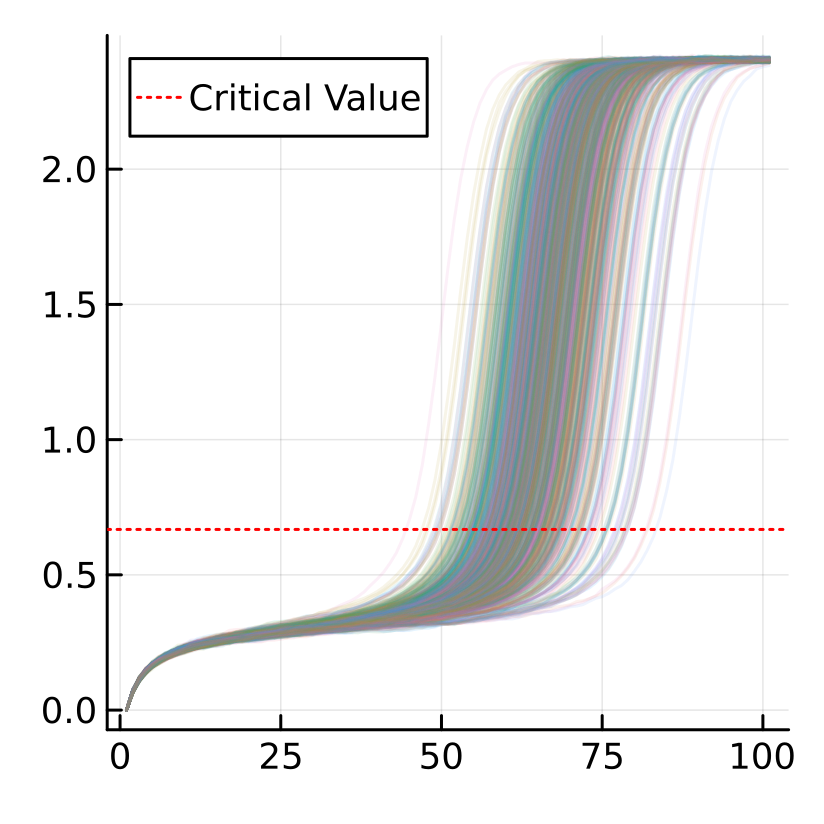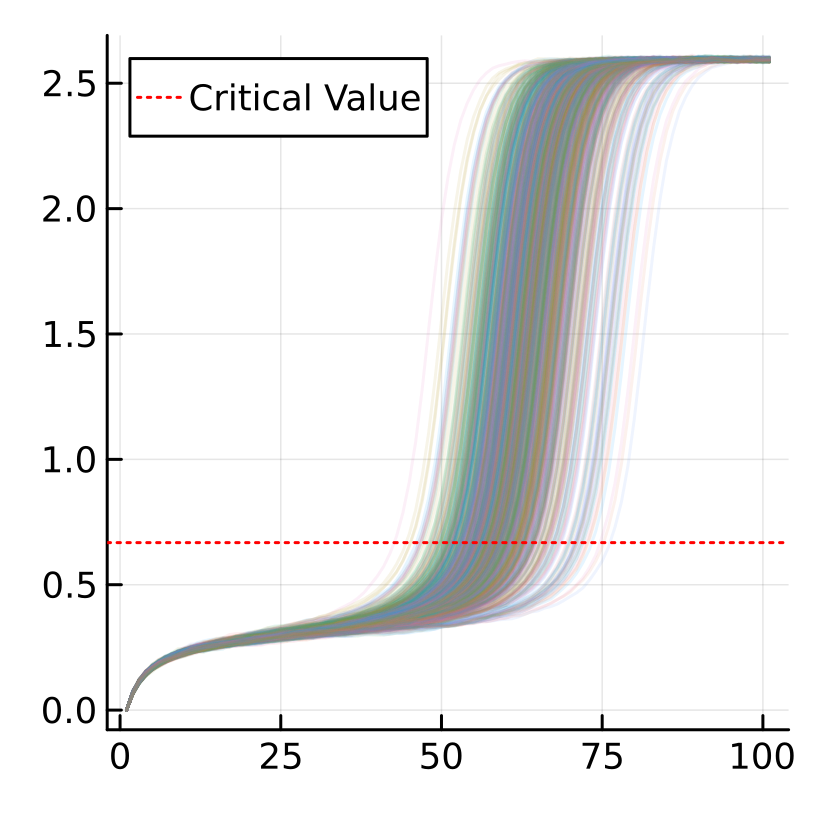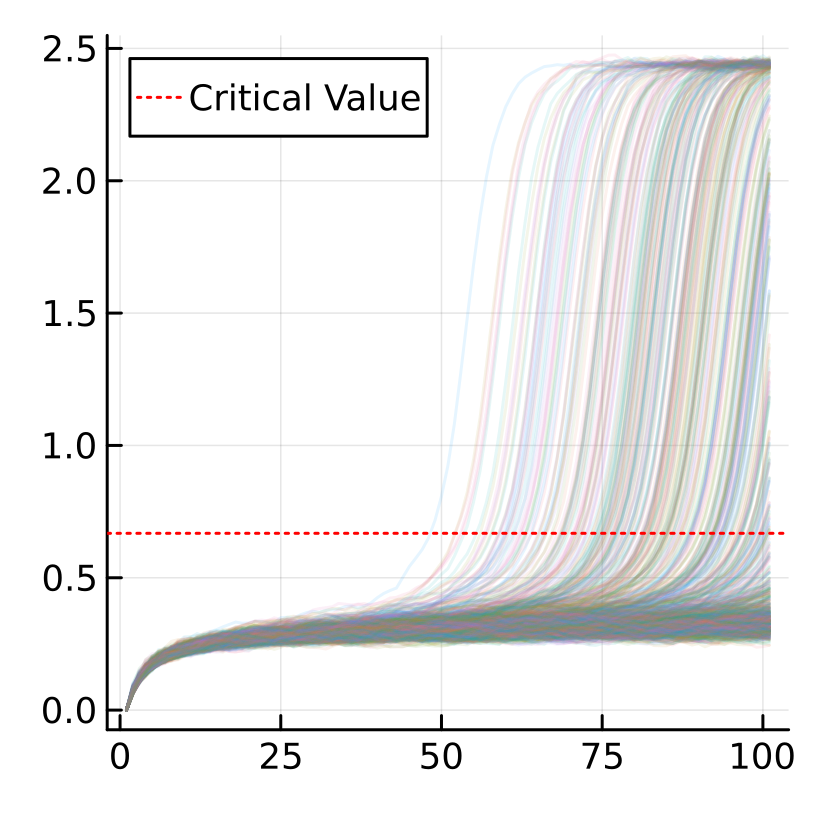class: center, middle .title[Robustness] <br> .subtitle[BEE 4750/5750] <br> .subtitle[Environmental Systems Analysis, Fall 2022] <hr> .author[Vivek Srikrishnan] <br> .date[November 7, 2022] --- name: toc class: left # Outline <hr> 1. Project Due Dates 2. HW Plan 3. Questions? 4. Robustness --- name: poll-answer layout: true class: left # Poll <hr> .left-column[{{content}} URL: [https://pollev.com/vsrikrish](https://pollev.com/vsrikrish) Text: **VSRIKRISH** to 22333, then message] .right-column[.center[]] --- name: questions template: poll-answer ***Any questions?*** --- layout: false # Last Class <hr> * Simulation-Optimization Exercise --- class: left # Conceptual Assumptions of Optimization <hr> Optimization problems implicitly assume perfect specification of: * Model Structure * Parameters * Decision Alternatives/Specifications -- *Even with Monte Carlo simulation, need to make assumptions about distributional forms and parameters.* --- class: left # What If These Are Wrong? <hr> Optimization problems implicitly assume perfect specification of: * Model Structure * Parameters * Decision Alternatives/Specifications *If these components are mis-specified, what are the implications?* --- class: left # Reminder: Bifurcations <hr> .left-column[**Bifurcations** occur at thresholds when the qualitative behavior of a system changes. These thresholds are sometimes referred to as "tipping points" and are often associated with a *stable* state equilibrium transitioning to an *unstable* one.] .right-column[.center[]] --- class: left # Impact of Bifurcations On Misspecification <hr> .left-column[ $q=2.5$: .center[] .cite[Adapted from [Quinn et al (2017)](https://dx.doi.org/10.1016/j.envsoft.2017.02.017)] ] .right-column[ $q=1$: .center[] ] --- # A Few Relevant Quotes! <hr> > Reports that say that something hasn't happened are always interesting to me, because as we know, there are **known knowns**; there are things **we know we know**. We also know there are **known unknowns**; that is to say **we know there are some things we do not know**. But there are also **unknown unknowns** — the ones **we don't know we don't know**. And if one looks throughout the history of our country and other free countries, **it is the latter category that tends to be the difficult ones**. > > .footer[– Donald Rumsfeld, 2002 (emphasis mine)] --- # A Few Relevant Quotes! <hr> > It ain’t what you don’t know that gets you into trouble. It’s what you know for sure that just ain’t so. > > .footer[– Often attributed to Mark Twain (apocryphal)] --- template: poll-answer ***What can we do to reduce the risk of misspecification?*** --- # "Deep" Uncertainty <hr> This issue of mis-specification becomes particularly acute in the presence of *deep* uncertainties, which are uncertainties for which we cannot write down a consensus probability distribution. --- template: poll-answer ***What are some examples of deep uncertainty?*** --- # "Deep" Uncertainty <hr> We won't talk much more about deep uncertainties, but they make this issue of misspecification more acute. -- We might be able to discuss "expected" performance (more on this next week) in the presence of well-characterized uncertainties, but can you compute an expected value or quantile without a probability distribution? --- layout: false # Robustness <hr> What we'd like to have is a sense of how well a decision performs under *plausible* alternative specifications. This is referred to as **robustness**. --- template: poll-answer ***What do you think of when you hear the word "robustness"?*** --- layout: false # Robustness <hr> **Note**: We are using "robustness" in a slightly different sense than some other related uses. --- # Robustness <hr> The basic idea of robustness: summarizing how well a decision works across a range of different plausible futures. --- # Lake Problem and Robustness <hr> .left-column[ Let's consider the lake problem. Suppose we estimate $q=2.5$, $b=0.4$, and runoffs $y_t\sim~LogNormal(\log(0.03), 0.1).$ After testing against 1000 runoff samples, we decide to try a release of $a_t = 0.04$ units each year. ] -- .right-column[ .center[] ] --- # But If We're Wrong... <hr> .left-column[ But now suppose that actually $q=2.4$! ] .right-column[ .center[] ] --- # But If We're Wrong... <hr> .left-column[ Or that $b=0.38$... ] .right-column[ .center[] ] --- # But If We're Wrong... <hr> .left-column[ Or $$ y_t\sim LogNormal(\log(0.033), 0.2): $$ .center[] ] .right-column[ .center[] ] --- # Varying $q$ and $b$ <hr> .left-column[ Let's explore whether this strategy meets our constraint over a variety of $q$ and $b$ values: ] .right-column[ .center[] ] --- # Robustness Measures <hr> .left-column[ Given an assessment of performance over a variety of specifications (or **states of the world**), there are a number of metrics that can be used to capture robustness, and the choice can matter quite a bit. Two common ones are **satisfycing** and **regret**. ] .right-column[ .center[] ] --- # Satisfycing <hr> .left-column[**Satisfycing** metrics try to express the degree to which performance criteria are satisfied across the considered states of the world. ] .right-column[ .center[] ] --- # Satisfycing <hr> .left-column[A simple satisfycing metric: what is the fraction of states of the world (SOWs) in which the criterion is met, or $$ S=\frac{1}{N}\sum_{n=1}^N I_n, $$ where $I_n$ indicates if the performance criterion is met in SOW $n$. ] .right-column[ .center[] ] --- # Satisfycing <hr> .left-column[In this case, $S=0.58$. Other satisfycing criteria might measure the "distance" from the baseline case before the system fails. ] .right-column[ .center[] ] --- # Regret <hr> .left-column[**Regret** metrics capture how much we "regret" (or lose in value) worse performances across SOWs. ] .right-column[ .center[] ] --- # Regret <hr> .left-column[A simple regret metric: what is the average worsening of performance across SOWs? $$ R = \frac{1}{N} \sum\_{n=1}^N \frac{\min(P\_n - P\_\text{crit}, 0)}{P\_\text{crit}}, $$ where $P_\text{crit}$ is the performance criterion and $P_n$ is the performance in SOW $n$. ] .right-column[ .center[] ] --- # Regret <hr> .left-column[In this case, $R = 0.41$. Note: Commonly we care about *maximum* regret over the considered SOWs. There are lots of possible metrics! ] .right-column[ .center[] ] --- # Robustness Metrics <hr> We could use these metrics during our optimization procedure by: * minimizing regret or maximizing satisfycing as an objective; * using either as a constraint. A key point is that these different metrics, and even different metrics within the satisfying and regret categories, might rank decisions differently. --- # Other Considerations <hr> Some other considerations when conducting robustness assessments: * How are different SOWs generated? * --- # Key Takeaways <hr> * Optimization methods make assumptions about model and parameter specification. * This assumption can lead to very bad outcomes in the presence of nonlinear system dynamics such as bifurcations. * Robustness is an approach to measuring how well a decision performs under mis-specification. * Many different robustness metrics, make sure you choose one appropriate for the context. --- class: middle <hr> # Next Class <hr> * Introduction to Sensitivity Analysis